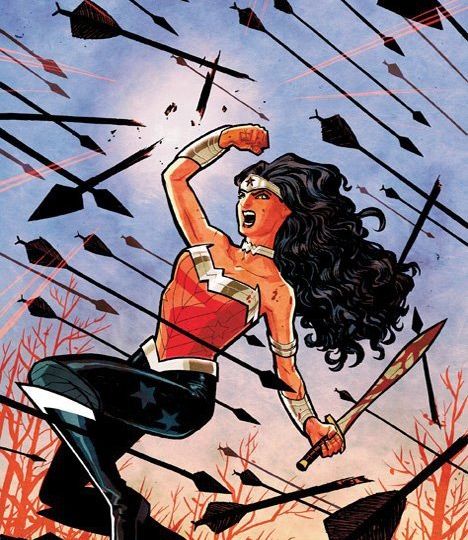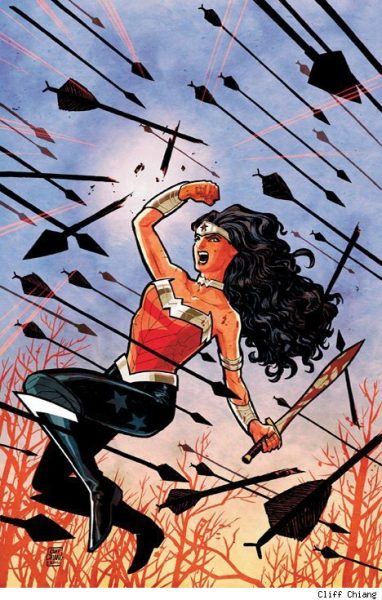
I didn’t know what to expect from this comic. While I’m familiar with her origin and the basic elements of her world, I admit that I’ve read only a couple of Wonder Woman comics. I haven’t even read a single issue of 100 Bullets, the multiple Eisner award winning comic written by Brian Azzarello, who pens this debut issue of Wonder Woman in the new 52. So you could argue that I’m not the best person to be doing this review. However, I am a big fan of Greek Mythology and superheroes, and I think Azzarello and artist Cliff Chiang have delivered an appealing fusion of the two with their Wonder Woman relaunch. They present the Greek Gods not as stiff beings who give grandiose speeches from above the clouds, but as deities who have personalities and walk among humans like wolves through a flock of sheep. This comic is a union of superheroes, horror, and Greek Mythology, and it’s one of the most creative and interesting relaunches in the new 52.
This issue opens with Apollo at the top of a skyscraper in Singapore. From the very first page, Azzarello pulled me into the story with his version of Apollo. This Apollo wears an expensive suit and courts beautiful women. He’s less of a glorious, shining sun god in a toga, and more of a devious god who wears suits made by the greatest tailors on Earth (or on Olympus?) and serves champagne to his unsuspecting victims. Chiang’s illustration of Apollo was also a unique and visually appealing depiction of the god; his skin is obsidian black and his eyes and mouth glow solar yellow. This Apollo looks like a dark sunspot, and it’s a visual style that comes across both as fitting for his menacing character, and different from the usual presentations of Apollo as a luminescent, golden god. Right off the bat, Azzarello and Chiang establish that their Greek Gods are not moral beings beyond reproach, but they are sociopathic immortals who place little to no value on mortal life.
The plot of this issue involves monster centaurs attacking a young woman named Zola. These centaur assassins were created from ordinary horses by a mysterious woman cloaked in peacock feathers. Azzarello emphasizes the horror of this comic as he has this mysterious woman draped in peacock feathers slice the heads off horses with a glowing scythe to make her centaur assassins. Instead of explicitly telling us who this woman is, Azzarello cleverly has her wearing peacock feathers. Here, Azzarello is letting the reader deduce the identity of the woman by only showing us her attributes as we know them from Greek Mythology. He doesn’t just tell the reader that this is Hera, but the peacock is that goddess’s bird, so we can assume that it is the queen of the gods who sent centaurs to kill Zola.
We see that Zola is protected by a strange looking man whom she understandably thinks is a home invader. Again, Azzarello doesn’t just tell the reader who this is, but rather he shows him in a helmet and carrying a messenger bag. Although we aren’t told his name, it’s clear that it’s Hermes who is protecting Zola. Chiang illustrates this Hermes almost like a gray alien instead of the beautiful youth that is his traditional depiction. He also has winged bird feet instead of winged sandals, which is an interesting artistic choice. This Hermes looks creepy with pale blue skin, big black eyes, and bird talons for feet. It’s an intriguing move to show the messenger of the gods as this otherworldy and alien being.
The centaur assassins break into Zola’s home and wound Hermes, but Zola escapes at the last second with some sort of magic key that teleports her into the bedroom of Wonder Woman. Even though Wonder Woman is sleeping, we see that this warrior woman is not easily surprised, and she snaps awake before Zola can even lay a finger on her. Wonder Woman lifts Zola off the ground by her throat, and the image of her lifting a small, lithe blonde woman brings attention to the fact that she’s a tall, big Amazon of a lady. Wonder Woman proceeds to get information from Zola about what is going on, and there’s a bit of tasteful yet gratuitous nudity as she gets out of bed and changes into her costume. Then, they are both transported by the magic key to Zola’s home.
teleports her into the bedroom of Wonder Woman. Even though Wonder Woman is sleeping, we see that this warrior woman is not easily surprised, and she snaps awake before Zola can even lay a finger on her. Wonder Woman lifts Zola off the ground by her throat, and the image of her lifting a small, lithe blonde woman brings attention to the fact that she’s a tall, big Amazon of a lady. Wonder Woman proceeds to get information from Zola about what is going on, and there’s a bit of tasteful yet gratuitous nudity as she gets out of bed and changes into her costume. Then, they are both transported by the magic key to Zola’s home.
Wonder Woman singlehandedly fights off the two monster centaurs. The brutal horror is accentuated again here as Wonder Woman chops off the arm of one of the centaurs, and Chiang’s illustrations are as dynamic and action packed as you would expect from a comic about an Amazonian warrior woman. Azzarello overlays the fight scene with a set of captions that let us hear a conversation between Apollo and the three fates, and it’s a smart move to have this prophetic dialogue in a scene that could have just been simplistic fighting with no larger ideas behind it.
The conversation between Apollo and the three fates might be my favorite part of the comic. It’s extremely well written, and it reads like it was pulled straight from a Greek myth. The fates foreshadow a bad ending for the Olympians, and they describe something wearing “a crown of horns” and “a cape of blood” that ultimately reigns supreme over the defeated gods. It’s creepy and scary, and this use of prophecy as foreshadowing is an ingenious way to interest the reader in the story to come in the following issues.
After the fight with the assassin centaurs, Wonder Woman tends to Hermes who appears to be mortally wounded. Hermes tells us why Zola is so important: she is pregnant with the missing Zeus’s child. This explains why Hera would want to kill her. In Greek Mythology, Hera isn’t so kind to her husband’s mistresses, and it makes sense that she would try to kill Zola. In other words, Hera’s behavior in this issue fits with established continuity.
In the conclusion of this issue, Azzarello cuts back to Apollo at the top of a skyscraper. We see that the women he murdered in the beginning of the issue were sacrificed so that they could become the three fates, which is a clever explanation for Apollo’s murderous behavior. As the sun rises, Apollo is consumed with light, and we see that it’s only at night that he has dark, almost reflective skin. In the light of day, Apollo is like a living sun, and the three fates are burned up by their proximity to him. Again, the horror of the gods is emphasized as Apollo’s light melts away the humans to bones which fall to the streets of Singapore.
This comic suggests that if the Greek Gods existed, they wouldn’t be a pantheon of just and kind beings…they would be horrifying sociopaths who wouldn’t care about human life except when they needed to manipulate us in their constant power struggles. These gods are more like their representations in ancient Greek Mythology, and they remind me a bit of Neil Gaiman’s “Endless” from The Sandman. Wonder Woman is a mixture of Greek Mythology, superheroes, and creepy horror, and I think it’s a blend that works great. I’m on board for this series, and I’d highly recommend this issue.
















This might have been my favorite book this week.
I couldn't agree more. This was a fine start to the new revamp of Wonder Woman – and to date, my favourite of the main hero relaunches. I was intrigued by Azzarello's comment about this being a horror book and it is clear how he intends to go about this. There is something scary about immortal gods mingling with humans down below, looking on them as mere specks.
Which is a good starting point for Wonder Woman, being a border crossing guard for these cosmic entities. I particularly liked the brief cut to her London apartment. Azzarello shows her living among humans, as opposed to Picoult's silly choice to make her completely removed from present-day civilization.
To be honest, I was planning on skipping this one, but your review has got me rethinking my decision. I'll pick it up!